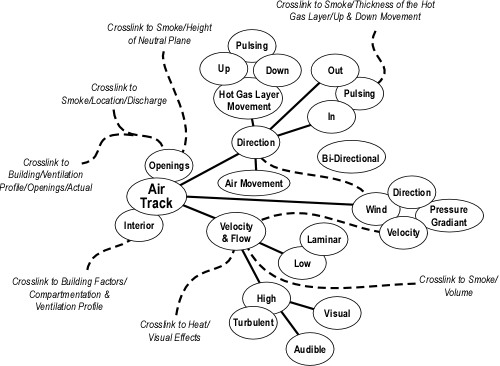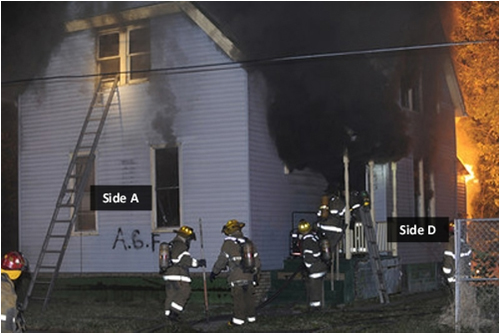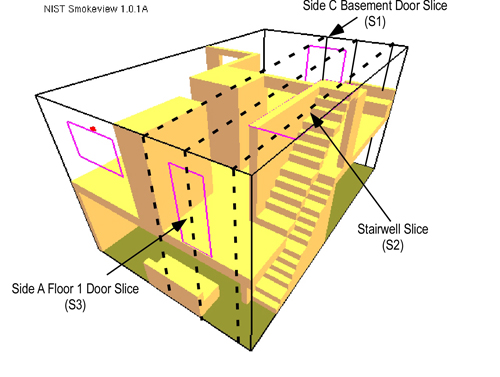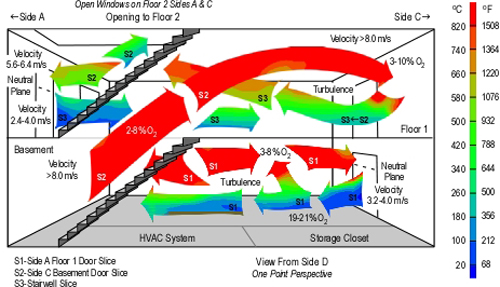Influence of Ventilation in Residential Structures:
Tactical Implications Part 7
The seventh tactical implication identified in the Underwriters Laboratories study of the Impact of Ventilation on Fire Behavior in Legacy and Contemporary Residential Construction (Kerber, 2011) is the influence of changes in ventilation on flow path.
“Every new ventilation opening provides a new flow path to the fire and vice versa. This could create very dangerous conditions when there is a ventilation limited fire” (Kerber, 2011).
Air Track and Flow Path
Air track and flow path are closely related and provide an excellent framework for understanding the influence of changes in ventilation on fire development and flow path.
Air Track: Closely related to flow path, air track is the movement of air and smoke as observed from the exterior and inside the structure. Air track is used to describe a group of fire behavior indicators that includes direction of smoke movement at openings (e.g., outward, inward, pulsing), velocity and turbulence, and movement of the lower boundary of the upper layer (e.g., up, down, pulsing).
Observation of air track indicators may provide clues as to the potential flow path of air and hot gases inside the fire building. As discussed in previous posts in this series (Part 1, Part 2, Part 3, Part 4, Part 5, Part 6), movement of air to the fire has a major impact on fire development. Movement of hot gases away from the fire is equally important!
Flow Path: In a compartment fire, flow path is the course of movement hot gases between the fire and exhaust openings and the movement of air towards the fire.
Both of these components of flow path are important! Movement of hot gases between the fire an exhaust openings is a major factor in heat transfer outside the compartment of origin and presents a significant thermal threat to occupants and firefighters. When the fire is in a ventilation controlled burning regime, movement of air from to the fire provides the oxygen necessary for fire growth and increased heat release rate (impacting on conditions in the flow path downstream from the fire.
Flow path can significantly influence fire spread and the hazard presented to occupants and firefighters.
Reading the Fire
Before engaging in the meat of this UL Tactical Implication, quickly review essential air track indicators used in the Building, Smoke, Air Track, Heat, and Flame (B-SAHF) fire behavior indicators organizing scheme.
Figure 1. Air Track Indicators

As illustrated in Figure 1, key indicators include wind direction and velocity (consider this before you even arrive on-scene), directions in which the air and smoke are moving, and the velocity and flow of smoke and air movement.
Take a look at Figure 2. Consider all of the B-SAHF indicators, but pay particular attention to Air Track. What is the current flow path? How might the flow path change if one or more windows on Floor 2 Side A are opened prior to establishing fire control?
Figure 2. Residential Fire in a 1 ½ Story Wood Frame Dwelling

Photo courtesy of Curt Isakson, County Fire Tactics
UL Focus on Flow Path
Tactical implications related to flow path identified in Impact of Ventilation on Fire Behavior in Legacy and Contemporary Residential Construction (Kerber, 2011) focus on creation of additional openings and changes in flow path as a result of “crews venting as the go” (p. 296). This is only one issue related to flow path!
The UL experiments showed that increasing the number of flow paths resulted in higher peak temperatures, a faster transition from decay to growth stage and more rapid transition to flashover. However, this is not the only hazard!
As previously discussed in the series of posts examining the fire in a Washington DC townhouse that took the lives of Firefighters Anthony Phillips and Louis Matthews, operating in the flow path presents potential for significant thermal hazard.
In this incident, the initial attack crew was operating on the first floor of a two-story townhouse with a daylight basement. When crews opened the sliding glass doors in the basement (on Side C), a flow path was created between the opening at the basement level on Side C, up an open interior stairway to the first floor, and out the first floor doorway (on Side A). Firefighters working in this flow path were subjected to extreme thermal stress, resulting in burns that took the lives of Firefighters Phillips and Mathews and serious injuries to another firefighter.
Figure 1. Perspective View of 3146 Cherry Road and Location of Slices

Note: From Simulation of the Dynamics of the Fire at 3146 Cherry Road NE Washington D.C., May 30, 1999, NISTR 6510 (p. 15) by Dan Madrzykowski and Robert Vettori, 2000, Gaithersburg, MD: National Institute for Standards and Technology.
Figure XX illustrates thermal conditions, velocity and oxygen concentration at various locations within the flow path.
Figure 10. Perspective Cutaway, Flow/Temperature, Velocity, and O2 Concentration

The temperature of the atmosphere (i.e., smoke and air) is a significant concern in the fire environment, and firefighters often wonder or speculate about how hot it was in a particular fire situation. However, gas temperature in the fire environment is a bit more complex than it might appear on the surface and is only part of the thermal hazard presented by compartment fire.
Convective heat transfer is influenced by gas temperature and velocity. When hot gases are not moving or the flow of gases across a surface (such as your body or personal protective equipment) is slow, energy is transferred from the gases to the surface (lowering the temperature of the gases, while raising surface temperature). These lower temperature gases act as an insulating layer, slowing heat transfer from higher temperature gases further away from the surface. When velocity increases, cooler gases (which have already transferred energy to the surface) move away and are replaced by higher temperature gases. When velocity increases sufficiently to result in turbulent flow, hot gases remain in contact with the surface on a relatively constant basis, increasing convective heat flux.
For a more detailed discussion of this incident and the influence of radiative and convective heat transfer in the flow path, see the prior posts on the Washington DC Townhouse Fire Case Study.
- Fire Behavior Case Study Townhouse Fire: Washington, DC
- Townhouse Fire: Washington DC-What Happened
- Townhouse Fire: Washington DC-Extreme Fire Behavior
- Townhouse Fire: Washington DC-Computer Modeling
- Townhouse Fire: Washington DC-Computer Modeling Part 2
Wind Driven Fires & Flow Path
While operating in the flow path presents serious risk, when fire behavior is influenced by wind, conditions in the flow path can be even more severe. In experiments conducted by the National Institute of Standards and Technology (NIST) demonstrated that under wind driven conditions, both temperature and heat flux, which were twice as high in the “flow” portion of the corridor as opposed to the “static” portion of the corridor (where there was no flow path). See the previous posts on Wind Driven Fires for more information on flow path hazards under wind driven conditions:
- Wind Driven Fires
- NIST Wind Driven Fire Experiments: Establishing a Baseline
- NIST Wind Driven Fire Experiments: Anti-Ventilation and Wind Control Devices
- NIST Wind Driven Fire Experiments: Anti-Ventilation and Wind Control Devices Part 2
Discussion
The sixth and seventh tactical implications identified in the UL Horizontal Ventilation Study are interrelated and can be expanded to include the following key points:
- Heat transfer (convective and radiative) is greatest along the flow path between the fire and exhaust opening.
- Exhaust openings located higher than the fire will increase the velocity of gases along the flow path (further increasing convective heat transfer).
- Flow of hot gases from the fire to an exhaust opening is significantly influenced by air flow from inlet openings to the fire (the greater the inflow of air, the higher the heat release rate and flow of hot gases to the exhaust opening).
- Flow path can be created by a single opening that serves as both inlet and exhaust (such as an open door or window).
- Thermal conditions in the flow path can quickly become untenable for both civilian occupants and firefighters. As noted in an earlier NIST Study examining wind driven fires, under wind driven conditions this change can be extremely rapid.
- Closing an inlet, exhaust opening, or introducing a barrier (such as a closed door) in the flow path slows gas flow and reduces the hazard downstream from the barrier.
- When the fire is ventilation controlled, limiting inflow of air (e.g., door control) can slow the increase in heat release rate and progression to a growth stage fire.
- Multiple openings results in multiple flow paths and increased air flow to the fire, resulting in more rapid fire development and increased heat release rate.
What’s Next?
The next tactical implication identified in the UL Horizontal Ventilation study examines an interesting question: Can you vent enough (to return the fire to a fuel controlled burning regime)? This question may also be restated as can you perform sufficient natural horizontal ventilation to improve internal conditions. The answer to this question will likely be extended through the Vertical Ventilation Study that will be conducted by UL in early 2012!
References
District of Columbia (DC) Fire & EMS. (2000). Report from the reconstruction committee: Fire at 3146 Cherry Road NE, Washington DC, May 30, 1999. Washington, DC: Author.
Kerber, S. (2011). Impact of ventilation on fire behavior in legacy and contemporary residential construction. Retrieved July 16, 2011 from http://www.ul.com/global/documents/offerings/industries/buildingmaterials/fireservice/ventilation/DHS%202008%20Grant%20Report%20Final.pdf
Madrzykowski, D. & Kerber, S. (2009). Fire Fighting Tactics Under Wind Driven Conditions. Retrieved (in four parts) February 28, 2009 from http://www.nfpa.org/assets/files//PDF/Research/Wind_Driven_Report_Part1.pdf; http://www.nfpa.org/assets/files//PDF/Research/Wind_Driven_Report_Part2.pdf;http://www.nfpa.org/assets/files//PDF/Research/Wind_Driven_Report_Part3.pdf;http://www.nfpa.org/assets/files//PDF/Research/Wind_Driven_Report_Part4.pdf.
Madrzykowski, D. & Vettori, R. (2000). Simulation of the Dynamics of the Fire at 3146 Cherry Road NE Washington D.C., May 30, 1999, NISTR 6510. August 31, 2009 from http://fire.nist.gov/CDPUBS/NISTIR_6510/6510c.pdf
National Institute for Occupational Safety and Health (NIOSH). (1999). Death in the line of duty, Report 99-21. Retrieved August 31, 2009 from http://www.cdc.gov/niosh/fire/reports/face9921.html
Tags: burning regime, fire behavior, fire behavior indicators, fire development, flow path, practical fire dynamics, reading the fire, situational awareness, vent controlled fire, ventilation



January 13th, 2012 at 07:34
[…] « Influence of Ventilation in Residential Structures:Tactical Implications Part 7 […]